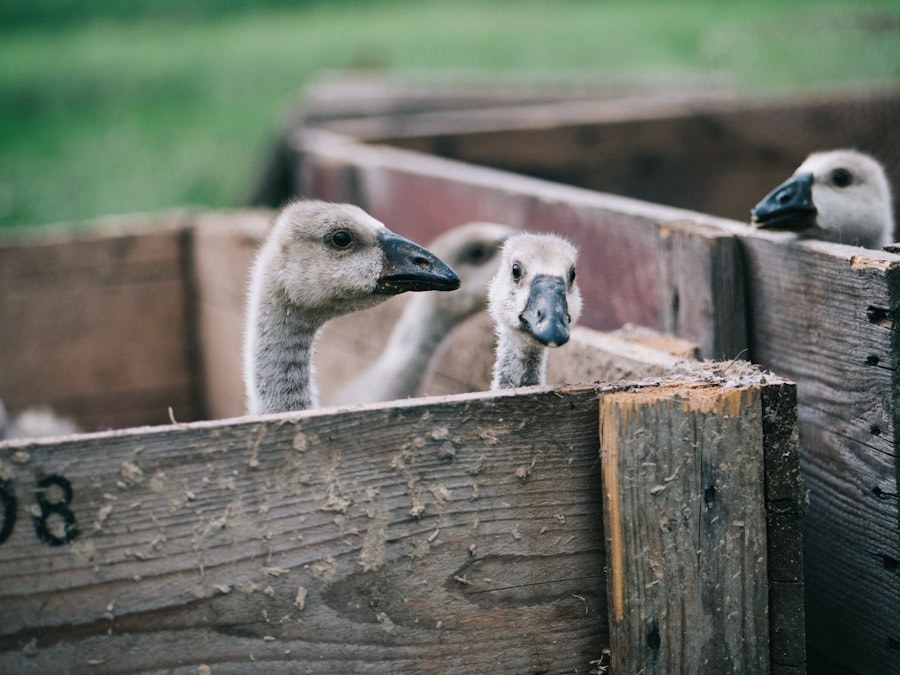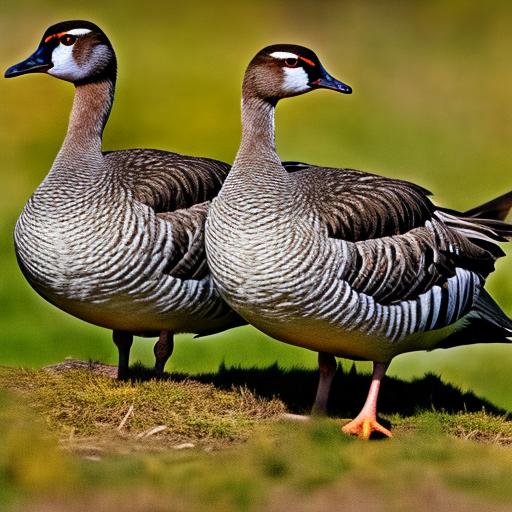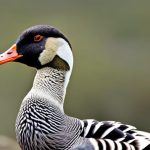Geese have been domesticated for thousands of years and have played an important role in agriculture. The domestication of geese is believed to have originated in ancient Egypt, where they were raised for their meat, eggs, and feathers. Geese were also used as guard animals, as their loud honking and aggressive nature made them effective at deterring intruders.
Geese are known for their adaptability and hardiness, which makes them well-suited for a variety of climates and environments. They are also highly social animals and thrive in groups. In addition to their agricultural uses, geese are also kept as pets and for ornamental purposes.
Key Takeaways
- There are many different breeds of geese, each with their own unique characteristics and uses.
- Domestic geese breeds are typically larger and more docile than wild geese breeds.
- Wild geese breeds are often migratory and have adapted to living in the wild.
- Heavyweight geese breeds are bred for their large size and meat production.
- Lightweight geese breeds are smaller and often used for egg production or as ornamental birds.
Domestic Geese Breeds
There are several popular domestic breeds of geese, each with its own unique characteristics and uses. One of the most well-known breeds is the Toulouse goose, which originated in France. Toulouse geese are large and heavy-bodied, with gray feathers and a calm temperament. They are primarily raised for meat production but can also be used for egg production.
Another popular domestic breed is the Embden goose, which originated in Germany. Embden geese are large and white, with a docile temperament. They are primarily raised for meat production but can also be used for egg production.
Domestic geese are known for their excellent foraging abilities and can graze on grass and other vegetation. They are also good at converting feed into meat and eggs, making them an efficient choice for small-scale farmers.
Wild Geese Breeds
In addition to domestic geese breeds, there are also several species of wild geese. Some of the most common species include the Canada goose, the snow goose, and the greylag goose.
Wild geese have different characteristics compared to domestic geese. They are generally smaller in size and have more streamlined bodies, which allows them to fly long distances during migration. Wild geese also have different coloration and markings compared to domestic geese.
While domestic geese are primarily raised for meat and egg production, wild geese are protected and not typically raised for agricultural purposes. However, they play an important role in the ecosystem and are often admired for their beauty and grace.
Heavyweight Geese Breeds
Heavyweight geese breeds are known for their large size and heavy bodies. These breeds are typically raised for meat production and can produce a significant amount of high-quality meat.
One example of a heavyweight breed is the Pomeranian goose, which originated in Germany. Pomeranian geese are large and have a distinctive knob on their forehead. They have a calm temperament and are known for their excellent meat quality.
Another heavyweight breed is the Steinbacher goose, which originated in Austria. Steinbacher geese are large and have a unique coloration, with white feathers on their body and black feathers on their head and neck. They are known for their tender meat and are often raised for gourmet purposes.
Raising heavyweight geese can have its advantages and disadvantages. On the positive side, these breeds can produce a significant amount of meat, making them a good choice for those looking to raise geese for meat production. However, they require more space and resources compared to smaller breeds, so it’s important to consider these factors before choosing to raise heavyweight geese.
Lightweight Geese Breeds
Lightweight geese breeds are smaller in size compared to heavyweight breeds but still have their own unique characteristics and uses. These breeds are often raised for egg production or as pets.
One example of a lightweight breed is the African goose, which originated in Africa. African geese are medium-sized with a distinctive knob on their forehead. They are known for their excellent egg-laying abilities and can produce a large number of eggs throughout the year.
Another lightweight breed is the Chinese goose, which originated in China. Chinese geese are small and have a slender body. They are known for their calm temperament and are often raised as pets or for egg production.
Raising lightweight geese has its advantages and disadvantages. On the positive side, these breeds require less space and resources compared to heavyweight breeds, making them a good choice for those with limited resources. However, they may not produce as much meat as heavyweight breeds, so it’s important to consider your specific needs before choosing to raise lightweight geese.
Ornamental Geese Breeds

Ornamental geese breeds are known for their unique and eye-catching appearance. These breeds are often raised for their aesthetic value and can be used in landscaping and decoration.
One example of an ornamental breed is the Sebastopol goose, which originated in Europe. Sebastopol geese have curly feathers that give them a distinctive and elegant appearance. They are often raised for their feathers, which can be used for crafts and decorations.
Another ornamental breed is the Pilgrim goose, which originated in the United States. Pilgrim geese are small and have a unique coloration, with gray feathers on their body and white feathers on their head and neck. They are known for their calm temperament and are often raised as pets or for ornamental purposes.
Ornamental geese can add beauty and charm to any landscape or garden. They are often kept in ponds or on small farms where they can be admired for their unique appearance.
Dual-Purpose Geese Breeds
Dual-purpose geese breeds are versatile breeds that can be used for both meat and egg production. These breeds are often preferred by small-scale farmers who want to maximize the productivity of their geese.
One example of a dual-purpose breed is the American Buff goose, which originated in the United States. American Buff geese are medium-sized with a calm temperament. They are known for their excellent meat quality and can also produce a good number of eggs.
Another dual-purpose breed is the Dewlap Toulouse goose, which originated in France. Dewlap Toulouse geese are large and have a distinctive dewlap under their chin. They are known for their tender meat and can also produce a good number of eggs.
Raising dual-purpose geese can be a practical choice for those who want to have both meat and eggs from their geese. These breeds offer the best of both worlds and can be a valuable addition to any small farm or homestead.
Rare Geese Breeds
Rare geese breeds are breeds that are at risk of extinction and are in need of conservation efforts. These breeds often have unique characteristics and genetic diversity that make them valuable for future breeding programs.
One example of a rare breed is the Cotton Patch goose, which originated in the United States. Cotton Patch geese are small and have a unique coloration, with white feathers on their body and gray feathers on their head and neck. They are known for their hardiness and adaptability to different climates.
Another rare breed is the Shetland goose, which originated in Scotland. Shetland geese are small and have a distinctive knob on their forehead. They are known for their excellent foraging abilities and can thrive in harsh environments.
Preserving rare geese breeds is important for maintaining genetic diversity and ensuring the future sustainability of these breeds. By supporting conservation efforts and raising rare breeds, we can help protect these valuable genetic resources.
Geese Breeds for Egg Production
There are several geese breeds that are known for their excellent egg-laying abilities. These breeds can produce a large number of eggs throughout the year, making them a good choice for those looking to raise geese primarily for egg production.
One example of a breed known for its egg production is the Roman goose, which originated in Italy. Roman geese are medium-sized with a calm temperament. They are known for their excellent egg-laying abilities and can produce a large number of eggs throughout the year.
Another breed known for its egg production is the Chinese goose, which was previously mentioned as a lightweight breed. Chinese geese are small and have a slender body. They are known for their calm temperament and can produce a good number of eggs.
When choosing geese breeds for egg production, it’s important to consider factors such as egg size, egg color, and overall productivity. By selecting breeds that are known for their egg-laying abilities, you can ensure a steady supply of fresh eggs on your farm.
Geese Breeds for Meat Production
There are several geese breeds that are known for their excellent meat quality. These breeds can produce a significant amount of high-quality meat, making them a good choice for those looking to raise geese primarily for meat production.
One example of a breed known for its meat production is the Embden goose, which was previously mentioned as a popular domestic breed. Embden geese are large and have a docile temperament. They are known for their tender meat and can produce a significant amount of meat per bird.
Another breed known for its meat production is the Toulouse goose, which was also previously mentioned as a popular domestic breed. Toulouse geese are large and have gray feathers. They are known for their excellent meat quality and can produce a significant amount of meat per bird.
When choosing geese breeds for meat production, it’s important to consider factors such as meat quality, growth rate, and overall productivity. By selecting breeds that are known for their meat production abilities, you can ensure a steady supply of high-quality meat on your farm.
Geese come in a variety of breeds, each with its own unique characteristics and uses. From domestic breeds like the Toulouse and Embden, to wild species like the Canada goose, geese have been an important part of agriculture for thousands of years. Whether you’re looking for a breed for meat production, egg production, or simply as a pet or ornamental animal, there is a goose breed that will suit your needs.
When choosing a goose breed, it’s important to consider factors such as size, temperament, and productivity. Heavyweight breeds like the Pomeranian and Steinbacher are known for their large size and excellent meat quality, while lightweight breeds like the African and Chinese are known for their egg-laying abilities. Ornamental breeds like the Sebastopol and Pilgrim can add beauty and charm to any landscape or garden. Dual-purpose breeds like the American Buff and Dewlap Toulouse offer the best of both worlds, with both meat and egg production capabilities.
In addition to considering your specific needs, it’s also important to consider the conservation of rare goose breeds. Preserving these breeds is important for maintaining genetic diversity and ensuring the future sustainability of these valuable genetic resources.
By choosing the right goose breed for your needs and supporting conservation efforts, you can enjoy the many benefits that geese have to offer. Whether you’re raising geese for meat, eggs, or simply as pets or ornamental animals, geese are sure to bring joy and productivity to your farm or homestead.
If you’re interested in learning more about different breeds of geese, you might also find this article on poultrywizard.com helpful. It provides valuable information on how to convert a shed into a chicken coop, which can be a great option for housing geese as well. Check it out here to discover practical tips and step-by-step instructions for creating a suitable living space for your geese.
FAQs
What are the different breeds of geese?
There are many different breeds of geese, including Toulouse, Embden, African, Chinese, and Canada geese.
What is the difference between Toulouse and Embden geese?
Toulouse geese are larger and have a more rounded body shape, while Embden geese are slightly smaller and have a more elongated body shape. Toulouse geese also have a darker plumage than Embden geese.
What is the origin of African geese?
African geese are believed to have originated in China and were brought to Europe by Dutch traders in the 17th century. They were then brought to North America in the 19th century.
What is the distinguishing feature of Chinese geese?
Chinese geese are known for their distinctive knob on their beak, which is more prominent in males than females. They also have a slender neck and a small, compact body.
What is the habitat of Canada geese?
Canada geese are found throughout North America and can be found in a variety of habitats, including wetlands, fields, and urban areas. They are also known to migrate long distances during the winter months.
Meet Walter, the feathered-friend fanatic of Florida! Nestled in the sunshine state, Walter struts through life with his feathered companions, clucking his way to happiness. With a coop that’s fancier than a five-star hotel, he’s the Don Juan of the chicken world. When he’s not teaching his hens to do the cha-cha, you’ll find him in a heated debate with his prized rooster, Sir Clucks-a-Lot. Walter’s poultry passion is no yolk; he’s the sunny-side-up guy you never knew you needed in your flock of friends!







